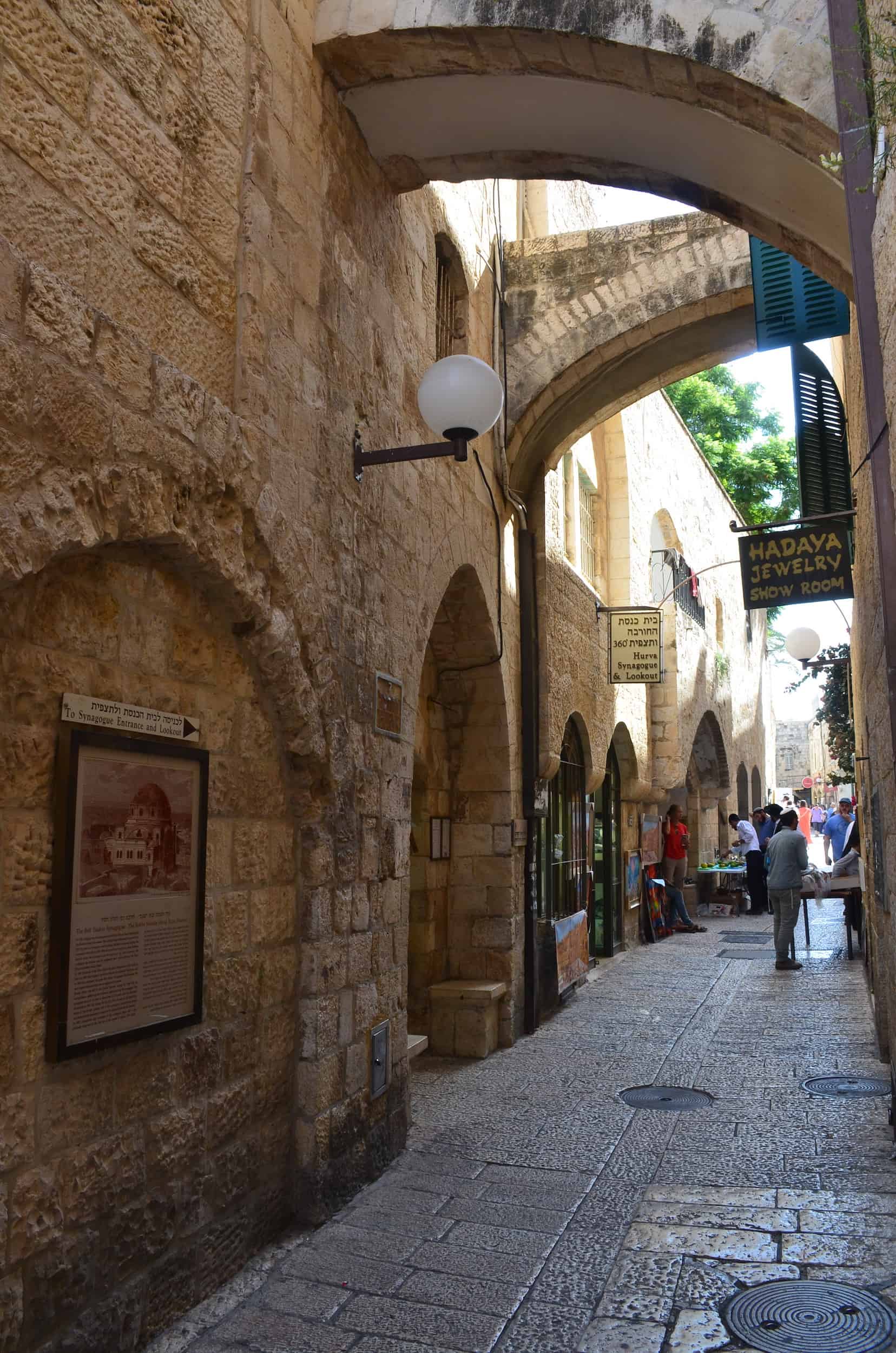Last updated on .
The Jewish Quarter makes up the southeast quadrant of the UNESCO World Heritage listed Old City of Jerusalem. It’s home to a number of synagogues and museums. This entry doesn’t include the Cardo, Hurva Synagogue, or Western Wall.

We visited the Jewish Quarter twice during our trip. Due to the Sukkot holiday, many attractions were closed or had limited hours. We weren’t able to see everything on our list.
The area was full of life, with restaurants packed and shops and squares quite busy. There were, however, a few empty streets we were able to wander through.
Hurva Square
Our first visit to the Jewish Quarter began with Hurva Square, which is surrounded by shops and fast food restaurants. The Hurva Synagogue is its centerpiece, and the Cardo runs along the west side.
Also on the square is the abandoned Sidna Omar Mosque. You can see the minaret standing next to the Hurva Synagogue.
Jewish Quarter Defender’s Memorial
On the north side of the Hurva Synagogue is the Jewish Quarter Defender’s Memorial. It commemorates the 39 soldiers and 30 Jewish Quarter residents who died in the Battle for Jerusalem during the 1948 Arab-Israeli War. The memorial contains several photos as well as a short video.
Four Sephardi Synagogues
A short walk south of Hurva Square are the Four Sephardi Synagogues, consisting of four adjoining synagogues built at different periods of time. They include the Yochanan ben Zakai Synagogue (early 17th century), Istanbuli Synagogue (1764), Eliyahu Ha’navi Synagogue (16th century), and the Emtsai Synagogue (18th century). The synagogues were closed to visitors when we walked by. Adult admission is ₪10 (as of November 2023) and they’re open daily except Saturdays.
Burnt House
Down an alley to the east of Hurva Square is the Burnt House. It’s an excavated house six meters below the current street level that dates back to the Second Temple period. The house was destroyed in 70 AD when the Romans set fire to Jerusalem. It’s open daily except Saturdays and adult admission is ₪20 (as of November 2023).
The house, which was excavated between 1969 and 1982, belonged to the priestly Kathros family. It included a small courtyard, four rooms, a kitchen, and mikveh. Findings from the house, such as pottery, coins, and jewelry, are on display. Also found was the forearm of a woman aged around 25 as well as a spear that may have belonged to a Jewish fighter living there.
25 minute screenings of a dramatic recreation of the destruction of the Second Temple take place about every 40 minutes. They include a multimedia guide available in several languages. The acting is bad and movie is cheesy and not based on fact, so you’re probably better off skipping the show.
Crusader Market
The Burnt House sits opposite a covered Crusader Market. The vaulted ceilings of the market later became cellars for the buildings above. The market was restored after the Six-Day War in 1967.
Herodian Quarter
Walking down towards the Western Wall, we came to the Wohl Archaeological Museum. It displays the remnants of upper-class houses in the Herodian Quarter. Like the Burnt House, these ruins were revealed after 1967. Adult admission is ₪20 (as of November 2022) and it’s open Sunday through Thursday. Unfortunately, we didn’t have a chance to visit.
Jerusalem Archaeological Park
Finally, just south of Western Wall Plaza is the Jerusalem Archaeological Park and Davidson Center. The Jerusalem Archaeological Park is an open-air archaeological site of what was once one of Jerusalem’s most important streets. The site was excavated in the 1970s. Adult admission is ₪30 (as of November 2023) and it’s open daily except Saturdays.
The Davidson Center is a museum within the archaeological park that includes a virtual reconstruction model of the Herodian Temple and findings from the site. Artifacts are from the First Temple, Second Temple, Byzantine, Crusader, and Ottoman periods, among others. We were unable to visit on this trip.